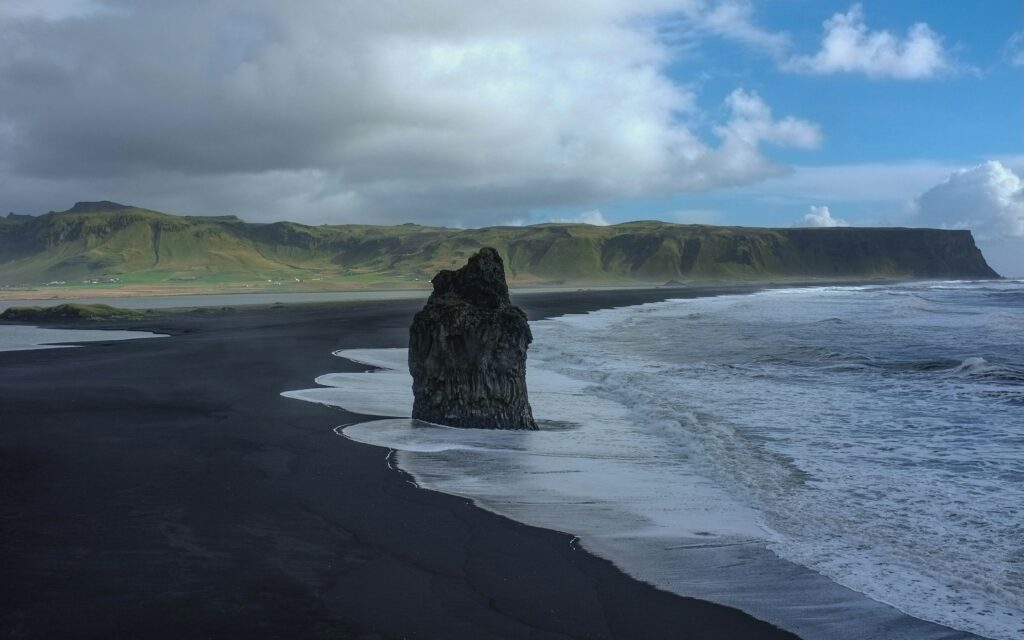Iceland’s coastline is wild, dramatic, and shaped by volcanic power.
It’s home to some of the world’s most striking black sand beaches.
These beaches are must-sees for travelers, nature lovers, and photographers.
The dark sand, towering cliffs, and crashing waves create a surreal landscape.
What makes them black? Volcanic eruptions.
The sand comes from cooled lava broken down over time.
You’ll find these beaches along the South Coast, the Snæfellsnes Peninsula, and in the Eastfjords.
Each one is unique, and all are unforgettable.
Here are 15 of the best you must visit on your next trip to Iceland!
Why Are Iceland’s Beaches Black?
As we touched on earlier, Iceland’s black sand beaches are the result of intense volcanic activity.
When basalt lava from eruptions reaches the ocean, it cools quickly and shatters into tiny fragments.
Over time, these fragments break down into fine black sand.
This process is very different from how golden or white sand forms, which usually comes from eroded coral, shells, or quartz over thousands of years.
In Iceland, fire and ice work together to shape the landscape.
Volcanic eruptions create the raw material, while glacier meltwater and powerful waves move and reshape it along the coast.
The result is a coastline that looks and feels entirely different from typical beaches around the world.
1. Reynisfjara Beach
Reynisfjara is Iceland’s most famous black sand beach, located just outside the town of Vík on the South Coast.
It’s known for its striking basalt columns, powerful Atlantic waves, and the towering sea stacks called Reynisdrangar, believed in legend to be trolls turned to stone.
The beach also features Arnardrangur, a large standalone sea stack, and the basalt cave Hálsanefshellir.
Puffins nest in the cliffs during summer, adding to its appeal. Reynisfjara has been named one of the world’s most beautiful beaches and is easily accessible from Route 1 with nearby parking and amenities.
Visitors should be extremely cautious—sneaker waves are common and can be deadly.
Swimming is strictly prohibited.
While it’s often crowded near the entrance, the eastern side past the cave is usually quieter.
2. Sólheimasandur
Sólheimasandur is a vast black sand desert formed by a glacial flood caused by the Katla volcano.
It’s located near Vík and just off Ring Road 1.
This area is best known for the wreckage of a US Navy DC-3 plane that crashed in 1973.
The abandoned fuselage lies far from the road and is reached by an hour-long walk, or by shuttle and guided ATV tours.
The site has a surreal, post-apocalyptic look and is a popular photography spot.
The beach itself stretches wide and feels remote, with no cliffs or ocean visible from the path.
It’s a stark, powerful reminder of Iceland’s raw natural forces.
3. Diamond Beach
Diamond Beach sits across from the Jökulsárlón Glacier Lagoon on the South Coast.
It gets its name from the glistening icebergs that wash ashore, scattered like diamonds across the black sand.
These ice chunks break off from the Breiðamerkurjökull glacier and drift through the lagoon before reaching the sea.
The visual contrast of crystal-clear ice on jet-black sand is stunning, especially during sunrise or sunset.
It’s easy to access directly from Route 1, with nearby parking and boat tours available on the adjacent lagoon.
Visitors are warned not to climb on the ice due to the risk of waves and slippery conditions.
4. Stokksnes
Stokksnes is a remote black sand beach located in East Iceland at the base of the dramatic Vestrahorn mountain.
Known for its reflective wet sands and sweeping dunes, the beach offers some of the most photogenic scenery in the country.
It includes a Viking movie set, a lighthouse, and panoramic views of the coast.
The beach is privately owned, and an entry fee is required.
On-site, visitors will find a cafe, guesthouse, and campsite.
It’s about a six-hour drive from Reykjavik, making it ideal for those exploring the Eastfjords.
The area is also a great place to view the northern lights on clear nights.
5. Djúpalónssandur
Djúpalónssandur is a dark shingle beach located on the Snæfellsnes Peninsula.
It’s surrounded by twisted lava formations and steep cliffs and carries a strong sense of Icelandic history.
The beach features the rusted remains of the Epine GY7 trawler, which wrecked here in 1948.
It also holds four ancient lifting stones that were once used by fishermen to test their strength.
The site feels wild and remote, with freshwater lagoons nestled in the cliffs.
A short walking path through lava fields leads visitors to the shore, which sits at the base of Snæfellsjökull glacier.
While scenic, the beach is dangerous—sneaker waves have made it risky, and visitors should keep a safe distance from the water.
6. Kirkjufjara
Kirkjufjara is a small black sand beach tucked between Reynisfjara and Dyrhólaey on Iceland’s South Coast.
It’s known for its steep cliffs and jet-black sand, but it has been closed to the public since 2017 due to the risk of rockfalls and dangerous waves.
While you can’t walk down to the beach, it’s still worth seeing from above.
The best views are from the Dyrhólaey viewpoint, where you can also take in Solheimafjara, Reynisfjara, Arnardrangur rock, and nesting puffins in summer.
Kirkjufjara remains a beautiful spot to observe from a safe distance.
7. Solheimafjara
Solheimafjara is a long, dramatic black sand beach stretching along the South Coast near Dyrhólaey.
The beach features coarse volcanic sand and smooth pebbles that appear grey when dry and deep black when wet, giving the surface a stripe-like pattern.
It can be viewed from above at the Dyrhólaey lighthouse, where the sweeping landscape is a favorite photo spot.
A less common access point is from the Solheimasandur DC-3 plane crash site—about a 4km walk from the parking lot, followed by a short path to the beach.
While vast and scenic, Solheimafjara remains less crowded than nearby Reynisfjara, making it a good option for quiet exploration.
8. Hvalnes Nature Reserve Beach
Hvalnes Nature Reserve Beach is a remote black shingle beach located in East Iceland, between a coastal lagoon and the open sea.
It’s known for birdlife, including whooper swans, and its panoramic mountain views on clear days.
The beach lies along a sharp curve in the Ring Road, near a lighthouse and a small parking lot.
A short walk across the shingle leads you from the lagoon to the ocean.
The contrast of black stones, water, and dramatic peaks makes Hvalnes feel like the edge of the world, especially when fog rolls in.
9. Lækjavik
Lækjavik is a small, lesser-known black sand beach in East Iceland.
It features a prominent sea stack rising from the shoreline, creating a scenic and peaceful setting.
The beach is close to the Ring Road, between Vestrahorn and the Eastfjords, with a rough track leading to a small parking area.
From there, visitors can enjoy elevated views or scramble over rocks to reach the beach itself.
Though remote, it’s a quiet stop for those exploring the East and looking to escape the more popular sites.
10. Eyrarbakki
Eyrarbakki is a quiet black sand beach on Iceland’s southern coast, just 55 minutes from Reykjavik.
It borders a small fishing village known for its history, birdwatching, and peaceful atmosphere.
The beach features dark volcanic sand mixed with rocks and runs alongside a disused harbor and old piers.
Unlike the more famous beaches, Eyrarbakki isn’t crowded with tourists, offering a more local and relaxed coastal experience.
It’s ideal for a short walk, some quiet photography, or simply enjoying the views in solitude.
11. Grotta
Grotta is a scenic black sand beach located in Seltjarnarnes, just 10 minutes from downtown Reykjavik.
It’s one of the easiest black sand beaches to visit without leaving the capital area.
The beach is home to a historic lighthouse that becomes an island at high tide, fish-drying structures, and a small hot pool called Kvika where visitors can soak their feet.
Bird nesting season closes the area from May to June, but the rest of the year it offers peaceful walks and ocean views.
Grotta is also a great spot to see the northern lights in winter due to its low light pollution despite being so close to the city.
12. Sandvik
Sandvik is located on the Reykjanes Peninsula, about an hour from Reykjavik, and features both black sand and volcanic rock.
It’s home to the Bridge Between Continents—a symbolic footbridge connecting the Eurasian and North American tectonic plates.
The beach is near Keflavik International Airport, making it a convenient stop at the start or end of a trip.
Visitors will find grassy dunes, open ocean views, and dramatic coastal scenery.
Sandvik was also used as a filming location for Flags of Our Fathers, adding a cinematic touch to the landscape.
It’s a quiet yet striking place to witness Iceland’s raw geology.
13. Dyrhólaey
Dyrhólaey sits directly across from Reynisfjara and offers one of the best elevated views of Iceland’s black sand coastline.
The area is known for its massive arch-shaped sea cliff, a lighthouse, and summer puffin colonies.
Often called the Endless Black Beach, Dyrhólaey stretches far into the horizon and feels incredibly vast from the clifftops.
There are two main parking areas—one at the viewpoint and one near the lighthouse, which may require a 4WD vehicle.
Accessing the beach below is not recommended due to strong waves.
Instead, walk along the peninsula to enjoy breathtaking views of the ocean, cliffs, and volcanic sands.
14. Lake Mývatn
Lake Mývatn in northern Iceland offers a unique black sand beach experience that’s safe and family-friendly.
Unlike Iceland’s coastal beaches, which are dangerous for swimming, the shores around Mývatn are calm and swimmable.
Located near geothermal areas and lava fields, the lake features dark volcanic sand with a gentler landscape.
It’s a great spot to relax, swim, or enjoy the view with kids.
Hot springs nearby add to the appeal, providing warmth after a chilly dip.
Reaching Mývatn takes about 5 hours and 45 minutes from Reykjavik, so it’s best visited as part of a longer northern route.
15. Seltjörn
Seltjörn is a small beach just 10 minutes from Reykjavik, offering a convenient alternative to longer drives.
While the sand here is more gray than deep black, it still gives visitors a sense of Iceland’s volcanic shoreline.
It’s best for a short walk or a quick stop when time is limited.
Though not as dramatic as other locations, Seltjörn is peaceful, easy to access, and suitable for anyone who wants a taste of Iceland’s coastal beauty without leaving the city.
Tips for Visiting Black Sand Beaches in Iceland
- Stay safe. Some beaches in Iceland, especially Reynisfjara and Kirkjufjara, are known for dangerous sneaker waves. These waves can appear suddenly and sweep people into the ocean. Never turn your back on the sea, and keep a safe distance from the water at all times.
- Wear good shoes. The black sand is not always soft. Many beaches have coarse grains, pebbles, or uneven surfaces. Solid walking shoes or hiking boots will help you stay comfortable and safe while exploring.
- Prepare for changing weather. Conditions along the coast can shift quickly. Rain, wind, and fog can move in without warning. Dress in layers and bring waterproof clothing to stay dry and warm.
- Respect nature. Stick to marked trails and obey warning signs. Many of these beaches are fragile environments or home to nesting birds. Staying on paths helps protect the landscape and keeps you safe from hidden dangers like unstable cliffs or sharp rocks.
Final Words
Iceland’s black sand beaches are some of the most striking places you can visit.
Each one has its own features—towering cliffs, scattered icebergs, or endless dunes.
They’re shaped by volcanoes, glaciers, and the ocean. No two are the same.
If you’re exploring Iceland, make time to see them.
These beaches are a powerful part of the country’s natural beauty!



